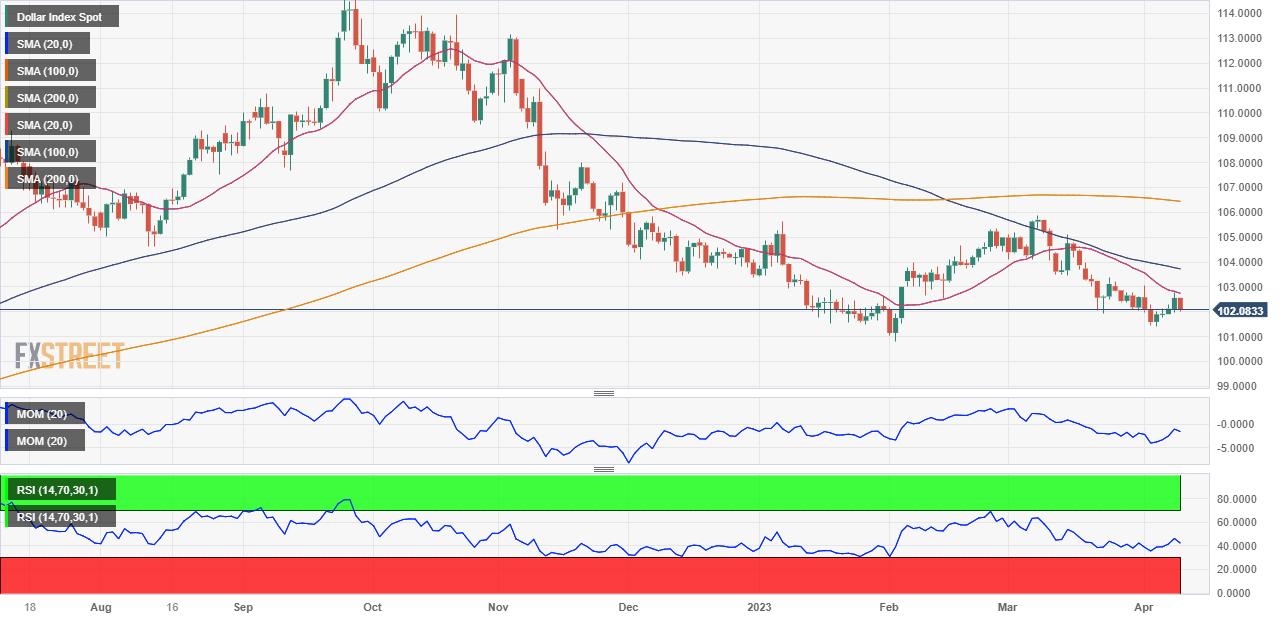- The US Consumer Price Index is expected to have risen by 5.2% YoY in March.
- The Federal Reserve has adopted a dovish stance amid the banking crisis.
- The US Dollar heads into the CPI release with a weak tone and with room to extend its slide.
The United States will publish the March Consumer Price Index (CPI) on Wednesday, which is expected to have risen by 5.2% YoY after increasing 6% in February. The core reading, however, is foreseen at 5.6%, up from 5.5% previously. Inflation cooled down in February, although at a slower pace than anticipated.
Effects on Federal Reserve’s decision
Market players were speculating on the Federal Reserve (Fed) potentially resuming its aggressive monetary tightening earlier this year amid the CPI tripling Fed’s goal. However, a new player came to town: banks’ failures. Silicon Valley Bank and Signature Bank failures were partly linked to the Fed’s decision to drain the financial system to control inflation. Fears arose globally, and Credit Suisse, the second-largest bank in Switzerland, faced massive withdrawals, leading to its collapse. Mid-March, UBS Group AG bought Credit Suisse with help from the government to prevent a steeper banking crisis.
Central banks were suddenly aware that monetary tightening was not only risking recessions. The Fed flipped to a more dovish stance and hiked its benchmark rate by modest 25 basis points (bps), anticipating one more 25 bps hike, before pausing. Rate cuts are foreseen in 2024, as the central bank plans to maintain rates high to cool inflation further.
So at this point, whether the March CPI comes better or worse than anticipated, it seems unlikely the Fed will change the magnitude of its rate hiking. Of course, a smaller-than-expected increase will be welcomed and trigger optimism, yet it is worth remembering the Fed’s favorite inflation measure is still the Core PCE Price Index and the effects of CPI on financial boards will likely be short-lived.
On the other hand, higher inflation data could boost concerns and end up favoring the US Dollar due to its safe-haven condition. Nevertheless, and as said before, the figures have little chances of having a long-lasting impact on financial markets.
Dollar Index Technical outlook
The Dollar Index (DXY) hovers around 102.10, and the bearish trend is evident in the daily chart, meaning its reaction will likely be more relevant in the case the report triggers a US Dollar sell-off. In the mentioned time frame, moving averages gain downward traction above the current level, in line with the dominant trend. The 20 Simple Moving Average offers dynamic resistance at around 102.75, while the 100 SMA comes next at 103.70. At the same time, technical indicators have resumed their declines after failing to overcome their midlines into positive ground.
The monthly low provides support at around 101.40, with a break below it sealing Dollar’s destiny and resulting in a test of the 100.00 threshold.

Information on these pages contains forward-looking statements that involve risks and uncertainties. Markets and instruments profiled on this page are for informational purposes only and should not in any way come across as a recommendation to buy or sell in these assets. You should do your own thorough research before making any investment decisions. FXStreet does not in any way guarantee that this information is free from mistakes, errors, or material misstatements. It also does not guarantee that this information is of a timely nature. Investing in Open Markets involves a great deal of risk, including the loss of all or a portion of your investment, as well as emotional distress. All risks, losses and costs associated with investing, including total loss of principal, are your responsibility. The views and opinions expressed in this article are those of the authors and do not necessarily reflect the official policy or position of FXStreet nor its advertisers. The author will not be held responsible for information that is found at the end of links posted on this page.
If not otherwise explicitly mentioned in the body of the article, at the time of writing, the author has no position in any stock mentioned in this article and no business relationship with any company mentioned. The author has not received compensation for writing this article, other than from FXStreet.
FXStreet and the author do not provide personalized recommendations. The author makes no representations as to the accuracy, completeness, or suitability of this information. FXStreet and the author will not be liable for any errors, omissions or any losses, injuries or damages arising from this information and its display or use. Errors and omissions excepted.
The author and FXStreet are not registered investment advisors and nothing in this article is intended to be investment advice.
Recommended Content
Editors’ Picks

EUR/USD remains bid around 1.1200, USD melts on tariff concerns
EUR/usd maintains its bullish stance well in place on Thursday, reaching the 1.1200 barrier and beyond on the back of intense selling pressure on the US Dollar, fuelled by concerns over the impact of Trump's tariffs on the US economy.

GBP/USD settles around 1.2950 on weaker Dollar
GBP/USD advances markedly and extends its breakout of the 1.2900 hurdle amid global trade war jitters and a severe sell-off in the Greenback, which was exacerbated following news of 145% US tariffs on China.

Gold resumes record rally, reaches $3,175
Gold extended its record rally on fresh tariff-related headlines, trading as high as $3,175 a troy ounce in the American session. The White House confirmed 35% levies on Mexico and Canada, 145% on Chinese imports, resulting in a fresh round of USD selling and pushing XAU/USD further up.

Cardano stabilizes near $0.62 after Trump’s 90-day tariff pause-led surge
Cardano stabilizes around $0.62 on Thursday after a sharp recovery the previous day, triggered by US Donald Trump’s decision to pause tariffs for 90 days except for China and other countries that had retaliated against the reciprocal tariffs announced on April 2.

Trump’s tariff pause sparks rally – What comes next?
Markets staged a dramatic reversal Wednesday, led by a 12% surge in the Nasdaq and strong gains across major indices, following President Trump’s unexpected decision to pause tariff escalation for non-retaliating trade partners.

The Best brokers to trade EUR/USD
SPONSORED Discover the top brokers for trading EUR/USD in 2025. Our list features brokers with competitive spreads, fast execution, and powerful platforms. Whether you're a beginner or an expert, find the right partner to navigate the dynamic Forex market.